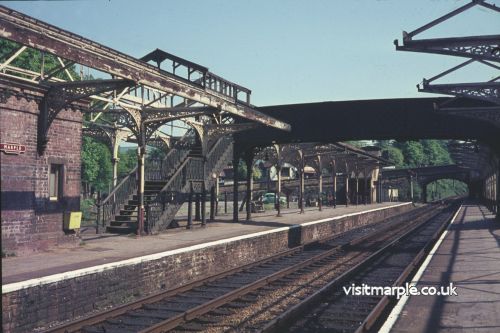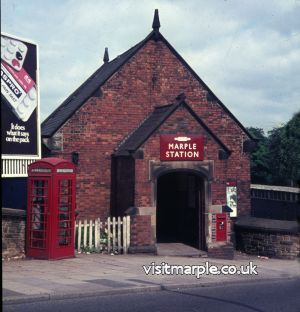XI. Marple Re-built. 1970
1. The Decision to Rebuild
With the rising costs of labour and materials of the 1960's, B.R. found itself no longer able to keep up with repair work on station buildings, and particularly canopies. This was nowhere more in evidence than at Marple; by the late 60's most of the fine canopies on both platforms had been allowed to get into such a state of disrepair that it was necessary to remove the glazing for safety, leaving the cast iron and timber skeleton giving little shelter. It is easy to criticise B.R. for this, but the station had been built for a Main line use that had long since disappeared; and with short diesel trains most of the platform was not even used. Nor could B.R. really afford, with the annual deficit into 8 figures, to spend money on renewing the 3 miles of timbering and 1600 panes of glass necessary to put Marple's roof back in order; in addition the footbridge from Brabyns Brow to Up platform was an expensive white elephant now the loop line had gone. What is more the buildings of the station were also expensive to maintain, and far too large for present needs. Staff had been greatly reduced in the 60's for economy, leaving one or at the most two porters and booking clerks on duty at any one time. There was no need for ticket collectors, shunters and foremen with the end of Main line services and the general decline in traffic. The closure of the goods yard further reduced staff requirements. Marple had also lost its Station Master in the reorganisation of 1967, when Area Managers were introduced, each having several stations under his control. Marple at first came under an Area Manager at Chinley, then in another reorganisation control was transferred to one at Ardwick East, and is now under the Area Manager Guide Bridge, whose responsibility stretches to Ardwick, New Mills, Woodhead and Broadheath: thus the station masters house stood empty. Parcels traffic had also declined, nor were ladies rooms now considered necessary. In other words of the large range on the Down platform only a few rooms were still in use. On (he Up, with the decline in passengers using the declining number of southward services, the waiting rooms had been boarded up out of use. Thus declining usage and facilities at the station, declining staff and spiralling costs contrived to make Marple an excessively large and ill-maintained station. It was indeed a sorry sight as I remember it, travelling to and from school; a vast range of half shut-up buildings, with an echoing, cavernous stair hall, and a gaunt skeleton of a roof in the platforms.
Marple Station in 1969, just prior to dismantling.
B.R. recognised the problem and realised something had to be done, as with the Ministerial refusal to even consider the closure of the line in 1966, the station's future seemed secure. Marple's Council and various other local bodies put pressure on B.R., with the result that in 1967 they promised to reconstruct the station. However in March 1968 B.R. stated "as a result of the extremely serious financial position in which we find ourselves it has been found necessary to defer the start of the construction of Marple Station . . . but this station remains high on our list of priorities". In February 1969, hopes were raised again that "in spite of pressure of commitments" work was likely to start that year; but nothing transpired. Later in the year B.R. regretted "that no date can be given for the scheme of improvements at Marple Station. The contract for the work has not yet been signed. The scheme is still on the priority list . Of course, the local press had a field day with all this delay, and there was criticism of B.R.'s plans especially as no canopies or public toilets were to be provided. Despite all this delay, B.R. did intend to rebuild, but were held up by shortage of capital; and it was in B.R.'s interest to build a new station as this would permit staff savings amounting to several thousand of pounds per annum. The cost of rebuilding was estimated at £39,000 including £7,000 for demolition of the old station. However, after so much delay, in January 1970 the work actually began.
2. The Plan for the New Station
B.R.'s plans were basically as follows: to remove all the existing buildings and ironwork as these were now superfluous to requirements; the footbridge was however to remain as it was quite sound, and would cost a 54igure sum to replace, and the signal box was also to survive as there was as yet no plan to resignal the line. The old platforms were to be retained as the base for new platforms, but were to be shortened: Marple's platforms were now too long, having been made to accommodate Main line trains, and were not now called upon to handle more than an 8~ar d.m.u. The platforms were however to be raised in height, as they were very low for modern coaches, having been built for the much lower and smaller stock of the 1860's and 70's. There was now no need for bays and loops, so the platforms need not be so broad as before, especially as the crowds for which they had been designed no longer occurred. The long footbridge between Brabyns Brow and Up platform had lost its purpose, now the lines it had straddled had gone, and was therefore to be removed.
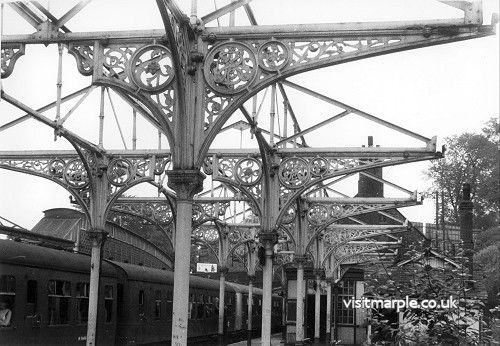
Marple Station on 2 August 1969 showing bare steelwork trusses.
On the other hand, there was a clear need for a car park, as people were already parking on the rough ground where the goods yard had been, and there was great potential for attracting car owners to use the station, if proper parking facilities were provided, as the roads out of Marple were jammed solid in the rush hour. There were also plans to revive the idea of connecting bus services, dead since the 1920's, by providing a bus-turning circle at the station. The only way that all these facilities could be provided was to use the space left derelict by the closure of the goods yard. It was essential that the new station should require as few staff as possible, to economise on what was already a loss-making line. With fewer passengers, the disappearance of most of the parcels traffic and simplified ticket issuing procedures, it was now practical for all the station work to be performed by one man for most of the day - except that is in the morning peak. But having only one member of staff would only be practicable if there was only one exit, as two exits would require two men to collect tickets. Also if the man collecting tickets also had to issue tickets, it would be essential to have the Ticket Office and Entrance/Exit as close together as possible, so that the man could book tickets up to the arrival of a train and then go out and collect tickets. In other words the sole entry and exit should be combined with the Ticket Office in one place. If it was anywhere on the Down platform, while being convenient for people coming from the Marple direction, it would be hopelessly inconvenient for those arriving by car or bus, or on foot from Marple Bridge; there could be no entry direct to the car park or Brabyns Brow to the Up platform if the sole entry was on the Down side. So the Ticket Office and entrance had to be on the Up side, convenient for the car park. This would also suit passengers walking to or from Marple Bridge; things would not be so convenient for pedestrians from Marple, who would have to detour to reach the Down platform for Manchester, but this would be compensated for by having an easier exit when arriving from Manchester. Thus the basic outline of the station as re-built was pretty well determined by the need for economy of staff, and the plan adopted was probably the best compromise for all the station's users.
The main entrance to Marple Station in 1969, just prior to demolition.
Therefore a combined ticket hall, waiting room and entrance/exit was to be sited near the footbridge, at the North end of the former goods yard, to give easy access to Up and Down platforms and the car park; to provide access to the station from Brabyn's Brow from the Marple direction, a set of steps were necessary on the site of the old footbridge, while pedestrian access from Marple Bridge and all vehicular access was to be via the old goods yard gate.
It was also decided to build two large and quite substantial waiting rooms on the Up platform for peak hour crowds; two were therefore erected, one on each side of the footbridge. This was however a mistake, as only a few trains were longer than two or at the most four coaches, and stopped opposite the footbridge and southern waiting room. Accordingly the northern waiting room was hardly ever used, and is now kept locked for most of the day. On the other hand no canopies or shelters were to be provided on either platform, nor was the footbridge to retain any covering, so that passengers using the bridge and waiting for trains are exposed to the elements. What is more both waiting rooms are now kept locked after 20.00 each evening due to vandalism. The money spent on the white elephant of a second waiting room could have been much better spent on providing a modest canopy on both platforms, and repairing the covering on the footbridge. It is a great pity that in the 60's and early 70's B.R. was so set against anything Victorian, as it would not have been difficult to retain several bays of the magnificent old roof, suitably refurbished to provide such cover in the vicinity of the footbridge on both platforms. The modern Ticket Office and waiting room could have been built under the canopy, and if suitably designed could have harmonised quite well. But B.R. were philistines in those ultra modernist late 60's, and were determined to have rid of the old. Nowadays the attitude has changed, and when other stations in the area were rebuilt a few years later, efforts were made to retain some of the canopy - Romiley and Hyde Central are examples. The basic layout of the new Marple was sound but with a little more thought, better shelter and buildings could have been provided for the same cost.
3. Demolition and Rebuilding
The contract for rebuilding was let to a firm called "Rata" of London early in 1970, and work began in late January. First of all a great ramp of scaffolding and planks was constructed behind the Down platform buildings to enable vehicles to gain access to the Up platform to bring in plant and materials, and remove demolition debris. The Down side waiting room was removed by burning it down, and then all the ironwork of the canopies was removed from the Down platform, leaving only the footbridge. This was done rapidly, and in February work started on removing the canopies on the Up side; the Up waiting room range was also demolished, with the exception of the gents toilet retained for use by the workmen. Early in March, with demolition half completed, bricks and concrete were delivered for the construction of the new buildings and work started as soon as sites were cleared. The most dramatic part of the work was the demolition of the long footbridge at the south end of the Up platform. First the roof was removed, then the timber sides and floor stripped, and finally each span cut away from its supporting pillar and from each other. Each span was then in turn lifted bodily by a large hired crane, and the supporting pillars and steps demolished. All of the station ironwork went for scrap, with the exception of a few of the 'S. & M.' roundels, which were rescued and preserved in private hands.
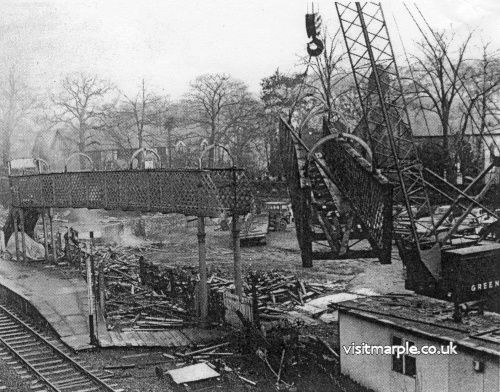
Demolition of Marple Station - March 1970. A mobile road crane removes the first span of the 1B75 footbridge linking the up platform to Brabyns Brow.
During all this, the station never closed, and access to both platforms had to be maintained at all times. It can be imagined therefore what a difficult job demolition was, and it is remarkable how smoothly it all went. In April work began on raising the platforms about 9 inches up to the required height, while the new buildings were rising. Fencing at the rear of newly raised and narrowed platforms followed in May, and soon after permanent electric light was installed; the gas lighting had been removed in January, and temporary electric lighting slung on wires draped about the station. By late August, the Up platform was substantially complete, and the Down nearly so, while the new buildings were ready for use. Accordingly the staff were transferred to their new accommodation on the Up platform, and the old booking office on the Down closed; the old buildings were quickly gutted, and demolished by early September, the site being flattened by using the rubble to fill in the former Down bay, and subsequently sown with grass. As the Autumn progressed, the car park was laid-out, with flagged paths around the sides, while the centre was covered with rubble and cinder hardcore. A staircase, erected in July, now linked the footpath from the booking hall to Brabyns Brow, for the benefit of passengers walking to or from Marple proper.
Tidying up continued throughout October, and the station was largely complete and tidy in time for the official opening. The whole reconstruction from start to finish cost £40,000, which was only £1,000 above the estimate.
4. The Official Opening
The station had of course never closed, but it was felt desirable to mark the reconstruction by a suitable ceremony. The station was not in fact quite ready by the day fixed for the Official Opening - 28th October 1970. The car park had not been surfaced, and the stairs up to Brabyns Brow still lacked banisters. The soon to be removed heaters had not yet been fixed in the waiting room, while the unpainted signal box looked out of place in a new station. In fact, on the morning before the ceremony, workmen were clearing debris and equipment left in the car park, while station staff swept and cleaned the station.
A special off-peak bargain fare of 2/- (10p) for a Day Return to Manchester, instead of the usual 5/- (25p) was offered to mark the opening day, to tempt passengers to the new station; quite good use was made of this facility due to good publicity in the form of posters put up in Marple. The booking hall was filled with a fine display of plants, provided by the Marple Council. There were some minor hitches in the preparation such as the discovery that the white tape to be "cut" by the first train to use the officially opened station was too short to stretch across the tracks; accordingly the lady relief clerk was dispatched into Marple to buy needle, thread and more ribbon to lengthen the tape!
The opening ceremony was to be performed by Councillor M.T. Burton, Chairman of Marple Urban District Council for 1970-71. That he should perform the opening ceremony was doubly appropriate, as not only was he a long-serving railwayman, but had also worked at Marple on occasions whilst a District Relief Goods Clerk. The official parties began arriving shortly before midday; first to arrive was Councillor M.T. Burton, to be followed by various officials and councillors of the Marple Council. These were followed by a group of Railway Officers, including K.J. Davies, the Divisional Manager, Manchester, the Divisional Civil Engineer, P. Robb (who was responsible overall for the reconstruction), the Public Relations Officer, and a member of the local Area Management staff from Ardwick. As well as these two official parties, there were reporters from papers as diverse as the "North Cheshire Herald" and "Guardian", and a crowd of spectators, including some retired long-service railwaymen.
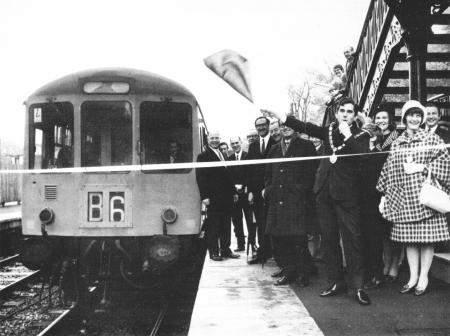
The Opening Ceremony for Marple's rebuilt station on Wednesday 2Bth October 1970. Councillor M. T. Burton, Chairman of Marple Council, and himself a railwayman flags away the 12.33 to Manchester, which will break the tape across the line.
At about noon the ceremony began; under the footbridge on the Down platform a small rostrum had been erected, surrounded by a floral display, and provided with a microphone. The Divisional Manager opened the proceedings with a speech, and was followed by Councillor M.T. Burton. He dwelt on the "Golden Age of Railways", with a brief account of the history of the station, and the services it enjoyed in its heyday; he speculated on the millions of passengers and thousands of tons of freight which must have passed through the station; the new station was compared to the old; and finally he exhorted people to use the new station.
Meanwhile the 12.00 train from Manchester, formed by a two car d.m.u. had arrived at the Up platform, and crossed over to form the 12.33 to Manchester, which was to be the "first" train to leave the officially opened station; the white tape was then stretched across the line between the pillars of the footbridge on either platform. Just before 12.33, Councillor Burton gave the "right-away" to the "first train" in approved railway manner by blowing a whistle and waving a green flag. This was repeated several times for the benefit of reporters and photographers before the train actually drew forward, broke the tape, and so departed. The station was thus declared officially open, and it is gratifying to note that the "first" train left on time at 12.33 precisely!
After a short tour of inspection of the station, during which it was noticed that vandals had already carved their initials on the new teak waiting room seats, the official party departed in cars for a substantial buffet lunch, with sherry, served in the Marple Council Offices. The day was rounded off by a film show provided by B.R. at the Old Folks Hall that evening, which despite atrocious weather attracted an audience of about 60.
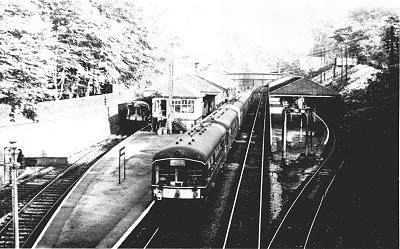
Marple in the early days of dieselisation in c.1961.2 "Derby Lightweight units are in the station - a 6 car set on a Manchester-Hayfield working at the up platform, while a Marple turn back lurks in the up loop. (Manchester Public Libraries)
5. Description of the New Station
The station as rebuilt had two platforms - the Up 442 feet long, the Down 485 feet, that is 105 and 65 feet respectively shorter than before. They are just capable of taking an 8-car d.m.u., and are more than ample for the normal two coach trains. The disused portion of the Up platform remains, albeit overgrown, and has on occasions been used to accommodate excursion trains of 10 coaches. The new platforms are much narrower than before, but quite ample for even the heaviest traffic encountered today; the Down is 10 feet wide throughout, while the Up is 15 feet wide at the North, broadening to 30 feet in the vicinity of the footbridge, and 11 feet for the lesser used Southern end. The tarmac-surfaced platforms are now about 3'6" high, which is almost level with the steps of modern carriages.
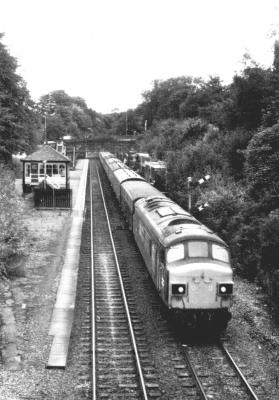 The Down Harwich Boat Train, the 7.2B Harwich Parkeston Quay - Manchester clatters through Marple on 12th August 1979. Note the overgrown remains of the up loop (left) and down bay (right). The 1875 footbridge is the only remaining parts of the old Station in use. The Signal box closed on Sunday 27th July 1980 and the semaphore signals have been replaced by modern colour lights. (Author)
The Down Harwich Boat Train, the 7.2B Harwich Parkeston Quay - Manchester clatters through Marple on 12th August 1979. Note the overgrown remains of the up loop (left) and down bay (right). The 1875 footbridge is the only remaining parts of the old Station in use. The Signal box closed on Sunday 27th July 1980 and the semaphore signals have been replaced by modern colour lights. (Author)
Linking the two platforms is the only piece of the 1875 station still in use - the footbridge. The timber decking and steps are modern, but the iron frame is as good as when built. The platforms are backed by a 6 foot high fence of vertical timbering, un-climbable except for the most acrobatic fare-dodger.
The buildings on both platforms are of red brick throughout, with flat roofs and white painted timber fascia boards at cornice level. Such box-like, flat roofed buildings have been very popular for the last 20 or 25 years, though they are now going out of fashion - the newest stations at Brinnington and Hattersley have reverted to pitched roofs. The use of a white fascia board clearly marks the building as of the late 60's or 70's while the use of homely brick is a reaction against the monstrosities of post-war modernist concrete and plastic architecture; what is more brick retains its appearance and durability much longer than concrete or plastic. The buildings of the new Marple Station are clearly a run-of-the-mill product of the late 60's, and while they lack the grandeur and self-confidence of Victorian architecture, they are not without a simple elegance.
The Down waiting rooms are large - too large if anything -each being 52 feet long and 13 feet wide. They are not quite identical, but differ only in the arrangement of windows and doors. While moderately attractive from outside, they are extremely uninviting inside, the overwhelming impression being cold and dark. There is not enough light, due to a shortage of windows, and the dark red brick walls heighten the gloom. The tiled floor is dark, cold and hard, and there are not enough seats. The only heating provided was a pair of tiny electric wall heaters in each room, completely inadequate for the size of the room; they have now been removed; for a space this size some better form of heating is required. So uninviting are the waiting rooms that even on cold and wet days most people prefer to wait outside or shelter under the footbridge. These modern rooms are gloomier, more cavernous and very much colder than the "outdated" Victorian ones they replaced.
The Up building is rather more pleasant inside; it is entered from the car park by a set of double doors and one single door, all of varnished teak, which was employed on much of the station woodwork. The doors are set back a few feet to provide a porch recess. The door onto the platform is of the sliding type, to permit the railman on duty to have only a narrow exit for ticket-checking purposes. The building consists of a ticket hall, office, staff mess room, staff toilet and two storage closets. The ticket hall is quite attractive, with good natural lighting from skylights in the roof, and the glass panelled doors. There is space for posters and information board and leaflet racks on the wall. The hall also acts as a small waiting room for the Up platform, and has a couple of seats for this purpose.
A large plate glass window looks directly from the adjoining office to the ticket hall, and this contains the booking window. Certainly this is more inviting than the little porthole in Victorian Booking Offices, and it is now possible to see who you are talking to and book a ticket without crouching down. The office contains one relic from the old station - the booking office clock, which still keeps excellent time. Adjoining is the staff mess room, with cooker, sink etc., to enable staff to make tea and enjoy a proper meal, without getting steam and cooking smells in the office. On the other side of the office is the staff toilet, and an alcove housing the parcels weighing machine, which can be rolled out to weigh long or bulky parcels. While Marple retains certain parcels services, it is necessary for the public to carry the parcels to or from the station; those requiring railway collection or delivery are dealt with at the parcels concentration depot at Manchester Mayfield. Consequently few parcels pass through Marple now. One major criticism of the Up building is that it is impossible to see out of the office to the platforms, due to the lack of windows; thus the staff cannot see when a train is coming so as to prepare to check tickets; nor can they keep a watch for vandals. The argument was that if windows were provided, they would encourage burglars, but if the windows had been made long and narrow, it would be impossible to use them for break-ins, while giving the staff surveillance of the platforms.
Outside the Up building, laid out on the site of the goods yard, is the car park, which is capable of taking about 80 cars without undue congestion. Paved footpaths lead from the ticket office to the main car park exit, for Marple Bridge pedestrians, and to a set of steps up to Brabyns Brow for those living in Marple itself. These steps have the same entrance onto the road as the old footbridge over the Up loop had. Below are the huts which house the local gang of Permanent Way Dept. platelayers, and Signal Maintenance staff.
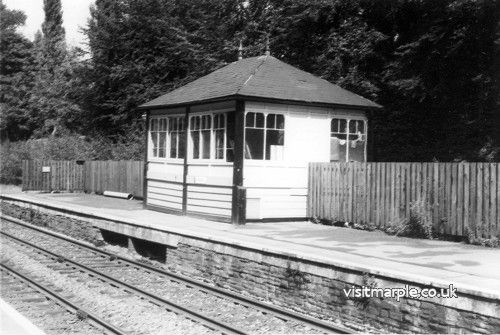
Marple Signalbox on the 12th September 1978 shortly before closure in July 1980. Built in 1905 to standard Midland design, with horizontal boarding on the lower storey, vertical boarding on the upper, sliding windows with cut-off top corners, a low pitched slate roof and 'Gothic' finials (Author).
At the other end of the station, on the Up platform stands another relic of the old station, the signal box, still operating until recently after 75 years service*. It is of a standard Midland design, easily recognisable by the sturdy four-square timber frame, with horizontal boarding in between on the ground floor, and vertical boarding in smaller panels beneath the windows at first floor level. The windows with cut-off corners at the top, are distinctively Midland, as are the gothic finials gracing the apex of the hipped slate roof. Inside a standard Midland lever frame is still in use, dating from the early years of this century; though of the 33 levers, 20 are painted white, denoting they are out of use and are relics of when Marple was a busy layout. The 13 in use are painted variously red, yellow or black denoting they control stop signals, distant signals, or points respectively. The only set of points still in use are at the South of the station, and are regularly used to turn back terminating trains. Above the lever frame is the "block-shelf", which houses the signalling instruments. The line through Marple being controlled by the "Absolute Block" method of signalling (which in its essentials dates from the late 19th Century), electric bells are used for all communication with the boxes on either side - Strines, and Marple Wharf; trains are "described" and emergency information conveyed by a laid down set of bell signals, while "Block Indicators" are used to give the signalman a visual reminder of the state of the line, i.e. whether the section of line between one box and the next is: a) available for occupation by a train ("Line Blocked"), or b) clear for the imminent passage of a train ("Line Clear"), or c) occupied by a train or obstructed ("Train on Line").
*Since this was written, Marple Signal box has closed under the Romiley-New Mills resignalling, which came into effect on Sunday 27th July 1980.
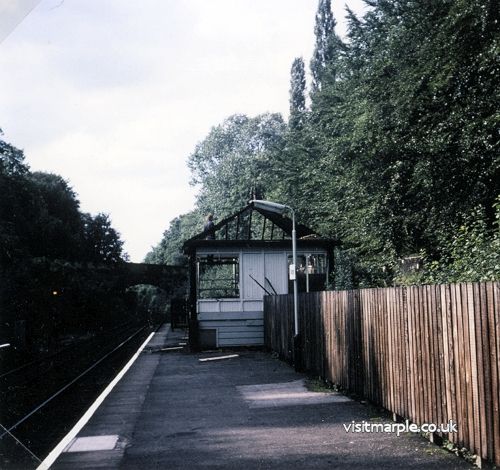
The signal box at Marple Station undergoing demolition, taken by R P Smith in July 1980.
When the station was rebuilt in 1970 the block bells and instruments in use dated from 1900 and were of solid Midland Railway make; but these were replaced by modern B.R. standard combined bells and indicators in 1976. The semaphore signals still in use at Marple are of modern B.R. type, but stand on the exact site of their Midland predecessors. Underneath the box on the "ground floor", now made a semi basement by the rise in height of the platform, are the batteries for the electrical instruments in the box, and the mechanical "interlocking" which is so arranged to physically prevent the signalman pulling a wrong lever; here also are the mechanical devices of pulleys, chains and levers which convert the pull on a lever into a movement of a rod or wire to operate points and signals.
The station today is largely as it was left when rebuilding was completed in October 1970, but there have been some subsequent improvements. As originally built the new booking office only had one booking window, quite insufficient for peak-hour business, when an additional booking clerk was brought to the station to cater for the demand. At first two clerks had to serve through one window, but this ludicrous situation was resolved later in the year by the installation of a second booking window.
The gap left by the demolition of the stair hall and entrance to the station on Brabyns Brow had left a large gap in the stone wall, which had originally been filled up with brick; this looked very unsightly and under pressure from Marple Council, B.R. replaced this by a proper stone wall, giving a much better aesthetic effect. The station car park had only been left half-finished when the station opened, and the finishing touches followed slowly. First of all, early in 1971, the entrance was widened to permit two cars to pass, easing the congestion on Brabyns Brow, and making the gateway less of a blind corner. Crash barriers were erected round the car park early in 1972 to protect pedestrians, but it took another year before the car park was finally tarmacked, and a proper kerb provided. Originally a charge was made for the use of the car park, which discouraged use of the station, and many passengers drove to Romiley where there was a free car park next to the station. After a few years of local pressure, B.R. removed charges and usage of the station by car-owners leapt up. Finally, 6 years after rebuilding, the signal box was repainted to match the rest of the station.
Marple as rebuilt appears a totally modern station, but in fact the basic layout of the site, bounded by great stone retaining walls east and west, and the Brabyns Park and Brabyns Brow overbridges north and south, is that of 1875; the platforms are greatly altered, but are built on those of 1865 and 1875, while the footbridge has not moved at all. And for those who look closely, there are many traces of the former glories of the station to be found hidden in undergrowth. I was sorry to see the decline and demolition of the old station but the new buildings serve the needs of Marple better and more economically than the old station could; it is a pity however that some of the magnificent canopy could not have been preserved for the very practical purpose of sheltering passengers.



